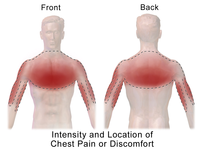
Photo from wikipedia
Epicardial adipose tissue (EAT) represents a cardio-metabolic risk factor; it secretes several adipokines related to coronary atherosclerosis. However, the precise relationship between EAT and coronary vasospasm is unknown. This study… Click to show full abstract
Epicardial adipose tissue (EAT) represents a cardio-metabolic risk factor; it secretes several adipokines related to coronary atherosclerosis. However, the precise relationship between EAT and coronary vasospasm is unknown. This study aimed to investigate the relationship between EAT and coronary vasospasm using data from the KoRean wOmen’S chest pain rEgistry (koROSE). This study included 551 patients (female/male = 366/185; mean age = 60.2 ± 10.2 years) who presented with chest pain at an outpatient clinic, and who subsequently underwent echocardiography and coronary angiography. Coronary artery stenosis (CAS >50% narrowing of at least one coronary artery) was detected in 223 patients (40.5%). The remaining 328 patients underwent the coronary spasm provocation test. Coronary spasm was defined as >90% narrowing induced by intra-coronary acetylcholine or ergonovine injection. EAT thickness was measured using transthoracic echocardiography according to American society of echocardiography recommendations. The mean EAT thickness was higher in the patients with CAS than in those without (8.09 ± 2.51 versus 6.88 ± 2.54 mm, P = 0.001) after adjusting for factors potentially influencing EAT thickness. Coronary vasospasm by provocation test was detected in 128 patients. The EAT thickness was higher in the patients with spasm than in those without (7.65 ± 2.52 versus 6.40 ± 2.45 mm, P < 0.001) but was not statistically different from that of the patients with CAS (P = 0.43). The EAT thickness had an independent relationship with CAS [odds ratio (OR) 1.166, 95% confidence interval (CI) 1.07–1.27, P < 0.001] and coronary vasospasm [OR 1.276, 95% CI 1.14–1.43, P < 0.001] after adjusting for clinical cardiovascular risk factors. EAT thickness is associated with coronary vasospasm and coronary atherosclerosis. The pathophysiology of coronary spasm may be similar to that of coronary atherosclerosis and could be an indicator of coronary stenosis.
Journal Title: Heart and Vessels
Year Published: 2017
Link to full text (if available)
Share on Social Media: Sign Up to like & get
recommendations!